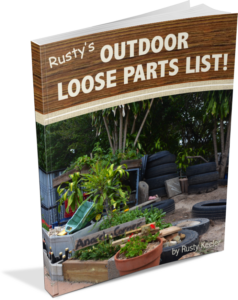Willow huts. Herb gardens. Sand pits. Sunflower houses. Tree tunnels. Stepping stones. You probably have a million ideas for ways to spice up your outdoor play space with new natural features. But how are you going to get all that work done?
You can’t do it ALL yourself. So what can you do? Hand shovels to your staff? Give children pick axes? Its actually not that difficult. Ask for help! Since the beginning of time communities have come together to work on collective projects such as farming, barn raising, and cathedral-building. The tradition continues today in the form of “community-built” projects. Its happening all over: communities come together to build playgrounds, paint murals, create mosaics and more. I love the community built process so much because I’ve seen it work over and over again. Whether you are building an entirely new playscape or just adding a handful of new features, this process might work for you too. My latest favorite version of the community build is the “swarm build” — where a large group of volunteers descend on a playscape for an afternoon, get job assignments, grab tools, and “go for it” to get the jobs done. I recently had the pleasure of joining a swarm build in Darmouth, Nova Scotia planned to coincide with an early childhood education conference I was a part of. The plan was for seventy-five conference participants to descend on the playscape to complete an amazing 15 different natural play projects. I’ve asked Lisa Davies the director to tell you the story of her swarm build, but I’ll give you the ending now: it was a success!
1. What is your Center and outdoor space like?
Dartmouth Child Development Center is a not for profit child care centre located in the city of Dartmouth, Nova Scotia. As an inclusive program, we have children with differing abilities, experiences, cultures and family forms attending and offer care to 52 children aged 3 months through 5 years. The outdoor playspace consists of a 40×56 ft fenced area surfaced with recycled rubber and a 16×168 ft long narrow space which is bent to an L shape. This space has dirt, and grass coverage with some gravel throughout. Neither were very pretty and each hosted lots of plastic houses, climbers, ride on toys etc. We had spent the past 3 years shifting the indoor environment to reflect natural, homelike qualities and we were ready to work on the outdoor space.
2. How did the opportunity to do a 2-hour community build arise?
I received a call from Elaine Ferguson, Executive Director of Child Care Connections Nova Scotia, in January of this year. She asked if we would be interested in hosting a workshop build for the upcoming Nurturing Nature conference in June. Our center is located within walking distance of the conference site and Elaine was keen to leave a ‘legacy’ of this conference for children. Immediately following the call, I hauled out our 2008 outdoor playspace plan. Here was an opportunity to add another piece to the playscape puzzle we had started. Little did we know how big it would become!
3. How did you PLAN for it?
The first thought was – Wow, maybe we’ll get a willow hut! The children will be crazy for it! Unfortunately, June is the wrong time of year to plant the rods (planned ahead for next year though!). Well, perhaps a teepee, walkway or bridge will be a good project for 10 – 12 people. Then I received an email from Elaine that there were 75 people registered for the workshop – yikes! What now?
We designed 14 projects for the two playspaces. There were new projects like the sunflower stage, teepee, bridge & creekbed, tire sea serpent, log- lined mudpit, planter box, cosy corner, musical fence, and a planted boat. Then there were upgrade or maintenance projects like painting the fence, hanging lattice, planting the vegetable garden, and hanging curtains on the gazebo. We took a good, long look at the yards and I feel we designed with the space rather than for the space. We wanted to ensure a good flow of movement between areas and, just like the indoor classroom, wanted to have quiet and loud spaces, spaces for movement and spaces to be still, and lots of spaces for exploration.
Recycling, reusing and repurposing materials is a key part of the environment of DCDC. Therefore, we wanted most of the materials for this build to fall into these categories. A list was drawn up of where we could apply for donations, items from families, local building materials. Local businesses donated materials or offered a discount, and we found many items, literally, in our own backyards! Running around gathering materials took the most time, but we soon built a pile of used wooden pallets, logs, plants, pots & pans, paint, lattice, and of course, the boat!
4. Describe the build.
The day of the build was sunny (one never knows in Nova Scotia). By 2:00, we had stations prepared for each project with all of the materials needed. We also prepared posters with directions for each project. Areas of 3 – 4 projects had a supervisor who could answer any questions and help with tools etc. Staff and their families come in very handy here!
As 75 early childhood educators arrived at 2:30, they were divided randomly into groups and they moved forward to their assigned project. Work got underway very quickly as we only had 1 hour and a half! As each team worked on their project, the supervisors traveled among them, trading up equipment (never enough shovels!) and offering water. Some groups finished earlier than others and moved to offer their services throughout the build ~ true community spirit. I was excited to see participants taking lots of pictures and hearing comments like “we could do this, you know that area…”. People were excited and anxious to apply this at their own centers.
5. What was constructed?
The pieces that people notice first are the 2 majestic teepees. One is made of crooked birch poles and the other of straight poplar ~ 2 very different looks. We had purchased a handmade wooden canoe and had been waiting to ‘plant’ it in the yard. It is now surrounded by tall ornamental grasses that wave in the breeze. A donated set of steps became a bridge from one area of the L shaped playspace to the other. This and the dry creekbed running under it provide a natural barrier for the children while we are waiting for the shade to come around. Four donated wooden pallets, plywood and some paint became a stage. Sunflowers were planted around it to grow into living walls. We hung a dozen pots and pans on the chain link fence for the toddlers, gave them some spoons, and beautiful music is made each day! One of the more labor intensive projects was the mudpit. We provided 2 foot logs for the perimeter and they needed to be set into the ground about 10 inches. Lots of turn taking with the pickaxe and we all worked together to fill the space with dirt. Under a natural canopy of maple trees, 3 log benches were placed on a bed of mulch while recycled tires were set into the ground vertically and painted as a serpent. Peas, beans, tomatoes, lettuce, green peppers and radishes were set into the available raised bed and another raised planter was built for some soft evergreen shrubs and scarlet runner beans.
6. How do the children like the transformation?
As children arrived Monday morning, they were buzzing about the pieces they could see from the Center entrance.
The highlight of the Toddler playspace was the musical fence. They played the pots endlessly using wooden and plastic spoons. The other pieces of this area were not as immediate for the children. Since the build though, they have been watching the vegetable garden grow, helping to weed and water regularly. The scarlet runner beans are beginning to climb the fence. Nurturing the plants and learning to respect them has been a big learning experience for this age group.
Many of the Preschool group had been discussing the build ahead of time, and were anticipating the changes. On this morning they discussed the projects and made a map of the space. When they went out, they followed the map and ‘discovered’ each new area. Later, when each child shared a favorite part, one said “all of it!” Prior to the changes, this group spent a lot of time dragging the portable plastic pieces around the yard. I have observed the new areas provide focus for their play and more opportunities for project work to emerge.
7. What tips do you have for other groups wanting to try a “swarm build” like yours?
Organization and lots of shovels! With that many people it was necessary to have every piece in place in order to have maximum use of the short time we had. The supervisors were absolutely key to having it all run smoothly. That way, each area had a “go to” person so everyone felt supported. I always feel visuals are a good tool as well, so the illustrated posters for each project were helpful. Maximize the community and use local resources where possible. Oh, and you don’t need lots of money. We were able to achieve all of our goals during this build for under $500.00! We are so very grateful to all involved for their donations of expertise, materials and time. It was truly a great experience and one I would repeat without hesitation.
Is that awesome or what? Think you could do that too? Yes! I know you can! On a related note: a related movement is cropping up among organic farms where I live in upstate NY called “Crop Mobs”: every month volunteers descend on a selected farm to help them with various tasks for a day—planting, harvesting, and processing food. Each month a different farm is highlighted and volunteers put in a day of work, get fed, make friends, go swimming, play music, etc. I wonder if a similar movement could happen in the early childhood world? What if all the childcare centers in your region created “playscape parties” and each month you would spend a half day building natural elements in their yards? Wow! Can you imagine? You could be networking, sharing resources, improving children’s environments all over, and when it was your center’s month with the help of your community, your playscape dreams can come true! Bring on the worker bees!

